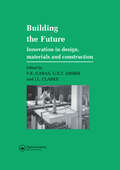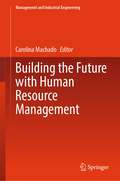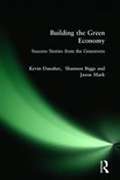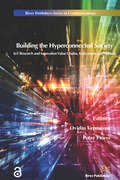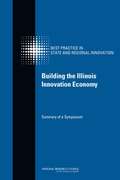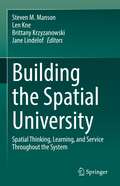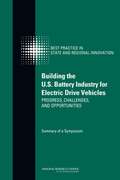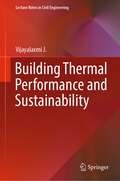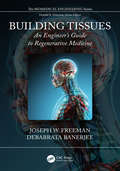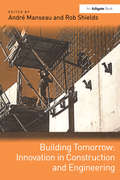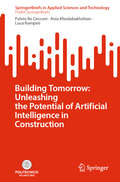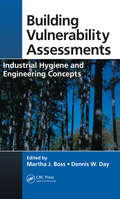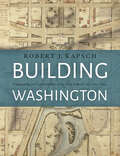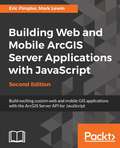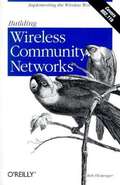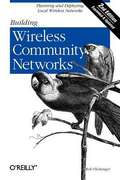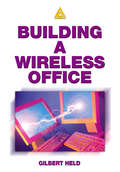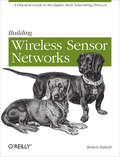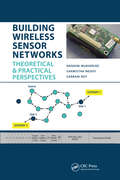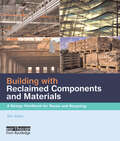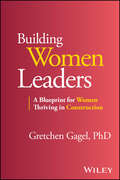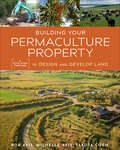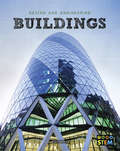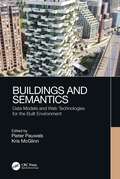- Table View
- List View
Building the Future: Innovation in design, materials and construction
by F. K. Garas G. S. T. Armer J. L. ClarkeThis book forms the proceedings of the international seminar held by the Institution of Structural Engineers and the Building Research Establishment in Brighton in April 1993. It brings together contributions from 20 countries on recent innovations in building and construction.
Building the Future with Human Resource Management (Management and Industrial Engineering)
by Carolina MachadoThis book explores the dynamic landscape of contemporary organizations, navigating through topics such as innovation, creativity, emotional intelligence, technology, and sustainability. The book shows how high-skilled workers synergize with machines, emphasizing the evolving nature of work into a talent-centric domain. It delves into human resource management, offering a comprehensive understanding of its strategic significance in fostering innovative, creative, and socially responsible organizations. The chapters guide the reader through an array of topics, from technological trends in HRM to the ethical dimensions of responsible management and the strategic approach to fostering gender equality. Each chapter, authored by experts in management and engineering, serves as a beacon of knowledge, providing executives, managers, engineers, academics, and students with the essential tools and insights needed to propel organizations into the future.
Building the Green Economy
by Kevin Danaher Shannon Biggs Jason MarkAfter centuries of economic activity based on extraction, exploitation, and depletion, we now face undeniable environmental threats. New business models that save or restore natural resources are critical. But how can we translate that insight into more sustainable practices? Building the Green Economy shows how community groups, families, and individual citizens have taken action to protect their food and water, clean up their neighborhoods, and strengthen their local economies. Their unlikely victories-over polluters, unresponsive bureaucracies and unexamined routines-dramatize the opportunities and challenges facing the local green economy movement.
Building the Hyperconnected Society- Internet of Things Research and Innovation Value Chains, Ecosystems and Markets
by Ovidiu Vermesan Peter FriessThis book aims to provide a broad overview of various topics of Internet of Things (IoT), ranging from research, innovation and development priorities to enabling technologies, nanoelectronics, cyber-physical systems, architecture, interoperability and industrial applications. All this is happening in a global context, building towards intelligent, interconnected decision making as an essential driver for new growth and co-competition across a wider set of markets. It is intended to be a standalone book in a series that covers the Internet of Things activities of the IERC – Internet of Things European Research Cluster from research to technological innovation, validation and deployment.The book builds on the ideas put forward by the European Research Cluster on the Internet of Things Strategic Research and Innovation Agenda, and presents global views and state of the art results on the challenges facing the research, innovation, development and deployment of IoT in future years. The concept of IoT could disrupt consumer and industrial product markets generating new revenues and serving as a growth driver for semiconductor, networking equipment, and service provider end-markets globally. This will create new application and product end-markets, change the value chain of companies that creates the IoT technology and deploy it in various end sectors, while impacting the business models of semiconductor, software, device, communication and service provider stakeholders. The proliferation of intelligent devices at the edge of the network with the introduction of embedded software and app-driven hardware into manufactured devices, and the ability, through embedded software/hardware developments, to monetize those device functions and features by offering novel solutions, could generate completely new types of revenue streams. Intelligent and IoT devices leverage software, software licensing, entitlement management, and Internet connectivity in ways that address many of the societal challenges that we will face in the next decade.
Building the Illinois Innovation Economy
by Charles W. WessnerResponding to the challenges of fostering regional growth and employment in an increasingly competitive global economy, many U. S. states and regions have developed programs to attract and grow companies as well as attract the talent and resources necessary to develop innovation clusters. These state and regionally based initiatives have a broad range of goals and increasingly include significant resources, often with a sector focus and often in partnership with foundations and universities. These are being joined by recent initiatives to coordinate and concentrate investments from a variety of federal agencies that provide significant resources to develop regional centers of innovation, business incubators, and other strategies to encourage entrepreneurship and high-tech development. Building the Illinois Innovation Economy is a study of selected state and regional programs to identify best practices with regard to their goals, structures, instruments, modes of operation, synergies across private and public programs, funding mechanisms and levels, and evaluation efforts. This report reviews selected state and regional efforts to capitalize on federal and state investments in areas of critical national needs. This review includes both efforts to strengthen existing industries as well as specific new technology focus areas such as nanotechnology, stem cells, and energy in order to improve our understanding of program goals, challenges, and accomplishments. As a part of this review, The Committee on Competing in the 21st Century: Best Practice in State and Regional Innovation Initiatives is convening a series of public workshops and symposia involving responsible local, state, and federal officials and other stakeholders. These meetings and symposia will enable an exchange of views, information, experience, and analysis to identify best practice in the range of programs and incentives adopted. Building the Illinois Innovation Economy summarizes discussions at these symposia, fact-finding meetings, and commissioned analyses of existing state and regional programs and technology focus areas, the committee will subsequently produce a final report with findings and recommendations focused on lessons, issues, and opportunities for complementary U. S. policies created by these state and regional initiatives.
Building the Spatial University: Spatial Thinking, Learning, and Service Throughout the System
by Steven M. Manson Len Kne Brittany Krzyzanowski Jane LindelofThis volume discusses the concept of The Spatial University as part of the broad growth of spatial science and the need for spatial infrastructure in colleges and universities. The book centers on the development of U-Spatial, the spatial science infrastructure at the University of Minnesota that offers a range of spatial activities and services, including data access, training, and community building. Against a backdrop of the changing nature of research, teaching, and service in higher education, the story of U-Spatial anchors a broader discussion of what it means to be a spatial university. This narrative framing demonstrates—with specific examples—the importance of institutions offering dedicated spatial research infrastructure. In six chapters, the text explores the importance of spatial thinking, learning, and research for student and researcher success. The volume offers lessons that are applicable far beyond the University of Minnesota to apply to a broad array of domains and institutional specializations. The book will be useful to students, researchers, and policymakers concerned with how institutions can encourage spatial research, teaching, and service. It will also appeal to researchers and practitioners interested in broader uses of spatial science.This book shows how GIS can transform a university, speaking to the need for leadership in higher education around the power of bringing everything together using spatial and geographic concepts. Jack Dangermond Co-Founder and President, Esri
Building the U.S. Battery Industry for Electric Drive Vehicles: Summary of a Symposium
by Charles W. WessnerSince 1991, the National Research Council, under the auspices of the Board on Science, Technology, and Economic Policy, has undertaken a program of activities to improve policymakers' understandings of the interconnections of science, technology, and economic policy and their importance for the American economy and its international competitive position. The Board's activities have corresponded with increased policy recognition of the importance of knowledge and technology to economic growth. The goal of the this symposium was to conduct two public symposia to review and analyze the potential contributions of public-private partnerships and identify other relevant issues for the Department of Energy, Office of Vehicle Technologies, Energy Storage Team's activities in the energy storage research and development area. The symposia will also identify lessons from these and other domestic and international experiences to help inform DoE as to whether its activities are complete and appropriately focused. Additional topics that emerge in the course of the planning may also be addressed. Building the U. S. Battery Industry for Electric Drive Vehicles: Summary of a Symposium gathers representatives from leading battery manufacturers, automotive firms, university researchers, academic and industry analysts, congressional staff, and federal agency representatives. An individually-authored summary of each symposium will be issued. The symposium was held in Michigan in order to provide direct access to the policymakers and industrial participants drawn from the concentration of battery manufacturers and automotive firms in the region. The symposium reviewed the current state, needs, and challenges of the U. S. advanced battery manufacturing industry; challenges and opportunities in battery R&D, commercialization, and deployment; collaborations between the automotive industry and battery industry; workforce issues, and supply chain development. It also focused on the impact of DoE's investments and the role of state and federal programs in support of this growing industry. This task of this report is to summarize the presentations and discussions that took place at this symposium. Needless to say, the battery industry has evolved very substantially since the conference was held, and indeed some of the caveats raised by the speakers with regard to overall demand for batteries and the prospects of multiple producers now seem prescient. At the same time, it is important to understand that it is unrealistic to expect that all recipients of local, state, or federal support in a complex and rapidly evolving industry will necessarily succeed. A number of the firms discussed here have been absorbed by competitors, others have gone out of business, and others continue to progress.
Building Thermal Performance and Sustainability (Lecture Notes in Civil Engineering #316)
by Vijayalaxmi J.This book highlights the various aspects of architectural research based on field studies and real-time data including the data collection methods and the methodology and materials required. The output of every study is knowledge based and informed decision that helps architects and designers in decision making process at an early stage. The output of the book bridges the architectural research methods and its application in contemporary world through a thorough understanding of sustainable building materials, construction techniques and its quantified consequences on thermal performance. This book is aimed at researchers and professionals to assist in understanding the strategies, tacts and methods of a scientific approach to assess building performance through real-life case studies from India. The implication of what is being done in the contemporary world is highlighted which will help practicing architects make design decisions.
Building Tissues: An Engineer's Guide to Regenerative Medicine (Biomedical Engineering)
by Debabrata Banerjee Joseph W. FreemanTissue engineering uniquely applies concepts and techniques from biology and engineering in order to heal or produce new tissues after disease or traumatic injury. A successful tissue engineer must have knowledge of cellular biology, cell signaling, extracellular matrix development, and tissue structure and integrate it with the application of stresses and strains, mass transfer, mechanical properties, and heat transfer. In order to train the next generation of successful tissue engineers, this text gives the reader a background in both the engineering and biology associated with tissue engineering.
Building Tomorrow: Innovation in Construction and Engineering
by André ManseauIn the past decade construction and engineering have changed dramatically, with an explosion of innovative new approaches to construction and new methodologies. By bringing together economic, social and construction/engineering management perspectives, this book offers a unique and comprehensive survey of these approaches and techniques. It presents a history of studies in innovation in construction and engineering, and then presents the most recent models of innovation brokering and risk-management, based on complex project-based industries. Innovation is defined and competing theories are discussed in the light of operational issues. The book covers all aspects, including the importance of construction and engineering 'cultures' in the trades for successful project innovation. It also discusses the role of government and policy makers, the implications of rapid change for the building trades and skilled labour, and the difficulty of measuring innovation quantitatively.
Building Tomorrow: Unleashing the Potential of Artificial Intelligence in Construction (SpringerBriefs in Applied Sciences and Technology)
by Fulvio Re Cecconi Ania Khodabakhshian Luca RampiniThis book explores the transformative impact of artificial intelligence (AI) on the construction industry, examining its readiness for widespread integration and its potential to reshape various facets of the construction lifecycle. It introduces the concept of a readiness metric tailored to the construction sector, providing a comprehensive framework for assessing and improving AI adoption. The narrative then shifts to the early stages of projects, highlighting the role of AI in promoting sustainability. From leveraging open data for data-driven decisions to using machine learning for strategic decisions in retrofitting and decarbonising the built environment, the book investigates how AI can be a catalyst for positive change in the construction process. It then explores the integration of AI into project and risk management, unlocking the potential of advanced analytics and predictive modelling to streamline processes and improve decision-making, and the application of AI in asset and facility management, highlighting how intelligent technologies can optimise the lifecycle of built assets. Examining the responsible use of AI tools, the book addresses ethical challenges and outlines guidelines for the conscientious and equitable integration of AI into the construction ecosystem. Overall, it serves as a comprehensive guide for industry professionals, researchers, and policymakers, providing insights into the current landscape, the potential of AI, and the ethical considerations necessary for responsible implementation.
Building Vulnerability Assessments: Industrial Hygiene and Engineering Concepts
by Martha J. Boss Dennis W. DayAll too often the assessment of structural vulnerability is thought of only in terms of security upgrades, guards, and entrance barriers. However, in order to fully ensure that a building is secure, the process of design and construction must also be considered. Building Vulnerability Assessments: Industrial Hygiene and Engineering Concepts focuses
Building Washington: Engineering and Construction of the New Federal City, 1790−1840
by Robert J. KapschA richly illustrated behind-the-scenes tour of how the nation’s capital was built.In 1790, George Washington and Thomas Jefferson set out to build a new capital for the United States of America in just ten years. The area they selected on the banks of the Potomac River, a spot halfway between the northern and southern states, had few resources or inhabitants. Almost everything needed to build the federal city would have to be brought in, including materials, skilled workers, architects, and engineers. It was a daunting task, and these American Founding Fathers intended to do it without congressional appropriation.Robert J. Kapsch’s beautifully illustrated book chronicles the early planning and construction of our nation’s capital. It shows how Washington, DC, was meant to be not only a government center but a great commercial hub for the receipt and transshipment of goods arriving through the Potomac Canal, then under construction. Picturesque plans would not be enough; the endeavor would require extensive engineering and the work of skilled builders. By studying an extensive library of original documents—from cost estimates to worker time logs to layout plans—Kapsch has assembled a detailed account of the hurdles that complicated this massive project. While there have been many books on the architecture and planning of this iconic city, Building Washington explains the engineering and construction behind it.
Building Web and Mobile ArcGIS Server Applications with JavaScript – Second Edition
by Eric Pimpler<P><P>Master the ArcGIS API for JavaScript to build web and mobile applications using this practical guide. <P><P>About This Book <P><P>Develop ArcGIS Server applications with JavaScript, both for traditional web browsers as well as the mobile platform <P><P>Make your maps informative with intuitive geographic layers, user interface widgets, and more <P><P>Integrate ArcGIS content into your custom applications and perform analytics with the ArcGIS Online <P><P>Who This Book Is For <P><P>If you are a web or mobile application developer, who wants to create GIS applications in your respective platform, this book is ideal for you. You will need Java Script programming experience to get the most out of this book. Although designed as an introductory to intermediate level book, it will also be useful for more advanced developers who are new to the topic of developing applications with ArcGIS Server. <P><P>What You Will Learn <P><P>To create an application with the ArcGIS API for JavaScript <P><P>Build and display a broad range of different geometry types to represent features on the map <P><P>The best way to leverage a feature layer and display related attribute data <P><P>The functionality of the wide range of widgets and how to use them effectively <P><P>Query data to gain new insights into the information it contains <P><P>Work with tasks to discover and locate features on the map <P><P>Using the geocoder and associated widgets <P><P>The ability of the API to provide turn by turn directions and routing capabilities <P><P>How to use the Geometry Engine and Geometry Service tasks for common geoprocessing operations <P><P>Integrate content on ArcGIS online and add it to your custom web mapping application <P><P>In Detail <P><P>The ArcGIS API for JavaScript enables you to quickly build web and mobile mapping applications that include sophisticated GIS capabilities, yet are easy and intuitive for the user. <P><P>Aimed at both new and experienced web developers, this practical guide gives you everything you need to get started with the API. After a brief introduction to HTML/CSS/JavaScript, you'll embed maps in a web page, add the tiled, dynamic, and streaming data layers that your users will interact with, and mark up the map with graphics. You will learn how to quickly incorporate a broad range of useful user interface elements and GIS functionality to your application with minimal effort using prebuilt widgets. As the book progresses, you will discover and use the task framework to query layers with spatial and attribute criteria, search for and identify features on the map, geocode addresses, perform network analysis and routing, and add custom geoprocessing operations. Along the way, we cover exciting new features such as the client-side geometry engine, learn how to integrate content from ArcGIS.com, and use your new skills to build mobile web mapping applications. <P><P>We conclude with a look at version 4 of the ArcGIS API for JavaScript (which is being developed in parallel with version 3.x) and what it means for you as a developer. <P><P>Style and approach <P><P>Readers will be taken through a series of exercises that will demonstrate how to efficiently build ArcGIS Server applications for the mobile and web.
Building Wireless Community Networks
by Rob FlickengerBuilding Wireless Community Networksoffers a compelling case for building wireless networks on a local level: They are inexpensive, and they can be implemented and managed by the community using them, whether it's a school, a neighborhood, or a small business. This book also provides all the necessary information for planning a network, getting the necessary components, and understanding protocols that you need to design and implement your network.
Building Wireless Community Networks, 2nd Edition
by Rob FlickengerBuilding Wireless Community Networks is about getting people online using wireless network technology. The 802.11b standard (also known as WiFi) makes it possible to network towns, schools, neighborhoods, small business, and almost any kind of organization. All that's required is a willingness to cooperate and share resources. The first edition of this book helped thousands of people engage in community networking activities. At the time, it was impossible to predict how quickly and thoroughly WiFi would penetrate the marketplace. Today, with WiFi-enabled computers almost as common as Ethernet, it makes even more sense to take the next step and network your community using nothing but freely available radio spectrum. This book has showed many people how to make their network available, even from the park bench, how to extend high-speed Internet access into the many areas not served by DSL and cable providers, and how to build working communities and a shared though intangible network. All that's required to create an access point for high-speed Internet connection is a gateway or base station. Once that is set up, any computer with a wireless card can log onto the network and share its resources. Rob Flickenger built such a network in northern California, and continues to participate in network-building efforts. His nuts-and-bolts guide covers: Selecting the appropriate equipment Finding antenna sites, and building and installing antennas Protecting your network from inappropriate access New network monitoring tools and techniques (new) Regulations affecting wireless deployment (new) IP network administration, including DNS and IP Tunneling (new) His expertise, as well as his sense of humor and enthusiasm for the topic, makes Building Wireless Community Networks a very useful and readable book for anyone interested in wireless connectivity.
Building Wireless Community Networks, Second Edition
by Rob FlickengerBuilding Wireless Community Networks is about getting people online using wireless network technology. The 802.11b standard (also known as WiFi) makes it possible to network towns, schools, neighborhoods, small business, and almost any kind of organization. All that's required is a willingness to cooperate and share resources. The first edition of this book helped thousands of people engage in community networking activities. This revised and expanded edition adds coverage on new network monitoring tools an
Building A Wireless Office
by Gilbert HeldSales of IEEE 802.11x compliant wireless LANs are exploding. Unfortunately the manuals accompanying the equipment do not address topics such as site selection, equipment interoperability with products from other vendors, and how to acquire and configure the different firewall, network address translation, and router software necessary when connecting to the Internet. Building a Wireless Office is a how-to guide that explains technical issues in non-technical terms. Written for a wide audience, it teaches how wireless LANs operate, the difference between available and emerging products, and why wireless LANs that operate at higher data rates may not be suitable or cost effective for all organizations.
Building Wireless Sensor Networks: with ZigBee, XBee, Arduino, and Processing
by Robert FaludiGet ready to create distributed sensor systems and intelligent interactive devices using the ZigBee wireless networking protocol and Series 2 XBee radios. By the time you're halfway through this fast-paced, hands-on guide, you'll have built a series of useful projects, including a complete ZigBee wireless network that delivers remotely sensed data.Radio networking is creating revolutions in volcano monitoring, performance art, clean energy, and consumer electronics. As you follow the examples in each chapter, you'll learn how to tackle inspiring projects of your own. This practical guide is ideal for inventors, hackers, crafters, students, hobbyists, and scientists.Investigate an assortment of practical and intriguing project ideasPrep your ZigBee toolbox with an extensive shopping list of parts and programsCreate a simple, working ZigBee network with XBee radios in less than two hours -- for under $100Use the Arduino open source electronics prototyping platform to build a series of increasingly complex projectsGet familiar with XBee's API mode for creating sensor networksBuild fully scalable sensing and actuation systems with inexpensive componentsLearn about power management, source routing, and other XBee technical nuancesMake gateways that connect with neighboring networks, including the Internet
Building Wireless Sensor Networks: Theoretical and Practical Perspectives
by Nandini Mukherjee Sarmistha Neogy Sarbani RoyBuilding Wireless Sensor Networks: Theoretical and Practical Perspectives presents the state of the art of wireless sensor networks (WSNs) from fundamental concepts to cutting-edge technologies. Focusing on WSN topics ideal for undergraduate and postgraduate curricula, this book: Provides essential knowledge of the contemporary theory and practice of wireless sensor networking Describes WSN architectures, protocols, and operating systems Details the routing and data aggregation algorithms Addresses WSN security and energy efficiency Includes sample programs for experimentation The book offers overarching coverage of this exciting field, filling a critical gap in the existing literature.
Building with Reclaimed Components and Materials: A Design Handbook for Reuse and Recycling
by Bill AddisInterest in green and sustainable design is growing throughout the world. Both national and local governments are active in promoting reuse and recycling in order to reduce the amount of waste going to landfill. This guide identifies how building designers and constructors can minimize the generation of waste at the design stage of a building project by using reclaimed components and materials. Authoritative, accessible and much-needed, this book highlights the opportunities for using reclaimed components and materials and recycled-content building products for each element of a building, from structure and foundations to building services and external works. Current experience is illustrated with international case studies and practical advice. It discusses different approaches to designing with recycling in mind, and identifies the key issues to address when specifying reclaimed components and recycled materials in construction work. This book will be invaluable for building professionals � including architects, specifiers, structural and service engineers, quantity surveyors, contractors and facilities managers � as well as students of architecture and civil engineering. Published with NEF
Building Women Leaders: A Blueprint for Women Thriving in Construction
by Gretchen Gagel“In the decades I’ve known Gretchen, I have watched her grow and excel as a mother, a civic and business leader, and an influencer in the construction industry. We are so fortunate that Gretchen carved out the time to write this seminal book on women’s leadership and I am confident that all will benefit from the knowledge she shares. Gretchen is a remarkable leader and role model who cares deeply for the construction industry, and her passion for helping women thrive helps us build a more inclusive industry.” —Mary K. Rhinehart, Chair, Johns Manville Corporation. Practical leadership guidance, inspiring stories, and actionable strategies for women and their male allies to elevate their careers in construction Building Women Leaders: A Blueprint for Women Thriving in Construction is a guide to becoming a successful female leader in the construction, engineering, mining, and energy industries. Featuring real-world case studies, inspiring stories of successful women leaders, and actionable strategies, this book serves as a catalyst for transformation, enabling organizations to harness the untapped potential of their female talent and drive innovation and growth. Leveraging the author’s 40-year industry career as a construction industry executive, female trailblazer, and advocate for women empowerment in the workplace, Building Women Leaders includes information on: Techniques for navigating a male-dominated industry, including understanding “dominant culture” and unconscious biasThe qualities of successful leaders in these industries, including what it means to lead versus manage and how Grounded Self-leadership is critical to authenticityGuidelines for building strong relationships and leading a diverse team with confidence, courage, and humilityWays to handle difficult conversations and conflicts, and the role of trust and vulnerability in these situationsHow to build support via professional organizations, networking groups, and training and development opportunities for women leaders Building Women Leaders is a timely, essential, up-to-date resource on the subject for leaders of all genders and at all levels and occupations in the engineering, construction, mining, and energy industries looking to harness the power of women in the workforce.
Building Your Permaculture Property: A Five-Step Process to Design and Develop Land (Mother Earth News Wiser Living Ser.)
by Rob Avis Michelle Avis Takota Coen&“A fresh, integrative, and holistic perspective on how to orientate oneself to the process of establishing your dreams and visions on the land.&” —Richard Perkins, author of Regenerative AgricultureBuilding Your Permaculture Property offers a revolutionary holistic method to overcome overwhelm in the complex process of resilient land design. It distills the authors&’ decades of experience as engineers, farmers, educators, and consultants into a five-step process complete with principles, practices, templates, and workflow tools to help you: Clarify your vision, values, and resources Diagnose your land and resources for strengths, weaknesses, opportunities, and threats Design your land and resources to meet your vision and values Implement the right design to enhance your strengths and improve your weakest resource Establish benchmarks to monitor the sustainability and success of your development. When designing a regenerative permaculture property, too many land stewards suffer from option paralysis, a lack of integrated holistic design, fruitless trial-and-error attempts, wasted money, and the frustration that results from too much information and no context.Building Your Permaculture Property is the essential guide for everyone looking to cut through the noise and establish an ecologically regenerative, financially sustainable, enjoyable, and thriving permaculture property, anywhere in the world. &“Highlights the need for permaculture design thinking in creating resilient, regenerative, landscapes and communities. Through this work, Rob, Michelle, and Takota make a valuable contribution to the ongoing evolution of permaculture thinking and action.&” —David Holmgren, permaculture co-originator &“Every farm, every ranch, and every homestead can benefit from thinking deeper about how human intent engages with the places we&’re blessed to call home.&” —Michael Phillips, author of The Holistic Orchard
Buildings: Design and Engineering for STEM (Design and Engineering for STEM)
by Alex WoolfDid you know that every building has a life cycle? That's what we call the stages from its design, construction, and opening to its use, maintenance, and demolition and disposal at the end of its useful life. This book explains what happens during these stages, such as planning, the sourcing of materials, the construction process, the decisions made by designers and engineers, and refurbishing and recycling.
Buildings and Semantics: Data Models and Web Technologies for the Built Environment
by Pieter PauwelsThe built environment has been digitizing rapidly and is now transforming into a physical world that is at all times supplemented by a fully web-supported and interconnected digital version, often referred to as Digital Twin. This book shows how diverse data models and web technologies can be created and used for the built environment. Key features of this book are its technical nature and technical detail. The first part of the book highlights a large diversity of IT techniques and their use in the AEC domain, from JSON to XML to EXPRESS to RDF/OWL, for modelling geometry, products, properties, sensor and energy data. The second part of the book focuses on diverse software solutions and approaches, including digital twins, federated data storage on the web, IoT, cloud computing, and smart cities. Key research and strategic development opportunities are comprehensively discussed for distributed web-based building data management, IoT integration and cloud computing. This book aims to serve as a guide and reference for experts and professionals in AEC computing and digital construction including Master's students, PhD researchers, and junior to senior IT-oriented AEC professionals.
